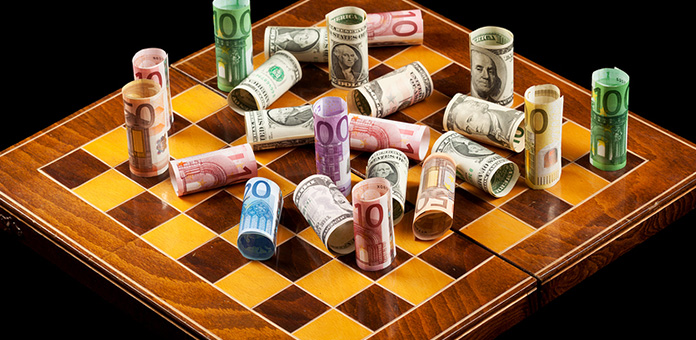
When world governments moved to decouple their currencies from a gold standard in the early 20th century, they were seeking greater flexibility for their central banks and monetary policy. However, some unforeseen consequences have taken the world by storm almost 100 years later.
When No Standard Exists
The basic concept of a world of fiat money—paper currency—is that governments are able to exert control over the value of their currency on the world markets. When a country’s currency is made to be relatively cheap compared to others (devaluation), that nation has an advantage in global trade. The differential in exchange rates creates cheaper exports and more potential for growth with increased levels of trade.
At the same time, each country must carefully balance the value of its currency against the goals and activities of other countries. If there is a perception of seeking too unfair an advantage, the result can bring retaliation. In fact, aggressive steps in this area can precipitate what is called a “currency war.”
Today’s Attack on the Archduke?
Historians like to look back and seek out the pivotal events that serve as the match that lights international wars and conflicts. Everyone looks back at the assassination of Archduke Ferdinand as the cause of WWI. However, many forces were at work prior to this one event, and it was those factors that really drove the world to global conflagration.
While it has been less than a month, many economists and analysts are looking for signs that Brexit might be the trigger for a significant currency war. In fact, many fear that the initials salvos have already been fired between potential warring parties.
Slew of Indicators
Since the vote to leave the EU, the pound had hit a 31-year low against the dollar, and many feel the worst is yet to come. The Fed is wringing its hands, fearful of raising rates to lessen the growing strength of the dollar. They see that U.S. exports are already suffering from the dollar rally that started before Brexit, with May numbers showing a 5 percent decline.
Just as savvy investors in gold took to it as a safe haven in growing numbers, many global traders are rushing to U.S. Treasuries as a preferred safe bet. Japan, also, is feeling the buying pressure. Another preferred currency, the yen and its increase in value are frustrating the government’s efforts to keep its valuation down to encourage more exports and growth.
Add to this mix a number of pressures built up in the past decade during continued global stagnation and financial unrest and the situation becomes a tinderbox for a currency war. These include: 1
- China recently set the renminbi at 6.6857 to the dollar, the weakest level since late in 2010. The deflationary effects of Brexit on China are creating new concerns about what steps that nation will take to protect its currency.
- Remaining EU members are trying to sort out how to protect the euro, now trading at only $1.10, and threatened further by concerns over other potential defections from the organization.
- U.S. policymakers are committed to controlling further growth in the value of the dollar, fearful that further increases will have a major ripple effect stagnating growth in the domestic economy.
As the roosters set loose in the 1930s continue to find their way home to economic basics, the potential for global currency devaluations is driving more investors to gold and silver for protection in the midst of uncertainty.
Christopher Vecchio, currency strategist at FXCM Inc., is not being an alarmist when he voices the growing sentiment, “It really looks like we’re on the cusp of FX [foreign exchange] wars. Competitive devaluations seem to be very much on the horizon.” 2
Additional Sources
2 – http://www.latimes.com/business/la-fi-brexit-currency-fallout-20160706-snap-story.html

